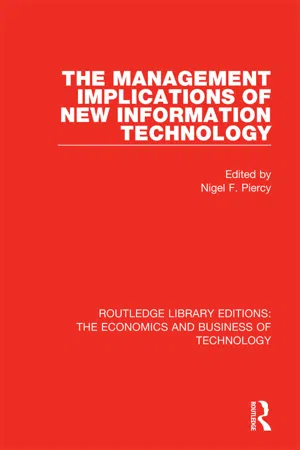Technology & Engineering
IT Skills
IT skills refer to the abilities and knowledge required to effectively use and manage information technology systems and tools. This includes proficiency in areas such as computer programming, network administration, cybersecurity, database management, and software development. IT skills are essential for individuals working in technology and engineering fields, enabling them to design, implement, and maintain complex technological solutions.
Written by Perlego with AI-assistance
Related key terms
2 Key excerpts on "IT Skills"
- Nigel F. Piercy(Author)
- 2018(Publication Date)
- Routledge(Publisher)
Chapter 2Information Technology in Engineering Production and Production Management
Denis R. TowillINTRODUCTION
Information technology (IT) is the modern name for the means by which we collect, store, process, and use information (Zorkoczy, 1982). Furthermore, it is not confined to hardware and software, but involves man in target setting and assessment criteria. It is built around the scientific, technological, engineering, and management disciplines used in information handling and processing, and at the present time is generally regarded as relating to computers and the interaction between man and machine. However, many of the basic ingredients needed within IT pre–date the microelectronic revolution. For many years effective management of manufacturing engineering has required the collection, generation, communication, recording, manipulation, and exploitation of information. A motivating factor in the new IT is the hope that the principles, practice, and terminology of information handling can be treated in a united, systematic way.Engineering production and production management are concerned with the effective use of people, products, plant and processes in modern manufacturing industry. This, in turn, is achieved by the proper selection and implementation of policies and plans. However, all six factors interact with each other, which partially explains the operational complexity which presently seems unavoidable. As we shall see, it is assisting the introduction of an integrated systems approach to problem solving in modern manufacturing industry which makes IT such a potentially powerful production management tool.The interaction problem can be best illustrated via the Venn diagram shown in Figure 2.1, in the type of display originated by Bestwick and Lockyer (1982). IT can help make each of the six cells independently more effective, but it is in the interactive zone where by far the biggest contribution may be expected. There are particular problems in the ‘people’ area, which are receiving exhaustive study under the heading of ‘dialogue engineering’ (Sime and Coombe, 1983).- eBook - ePub
Information Technology
An Introduction for Today's Digital World
- Richard Fox(Author)
- 2020(Publication Date)
- Chapman and Hall/CRC(Publisher)
1 Introduction to Information Technology In this chapter, we introduce the field of information technology (IT), cover definitions, explore the components that make up IT, and look at IT careers. The learning objectives of this chapter are to be able to: • Define the different uses of the term IT • Explain the types and roles of the components of a computer system • Describe and differentiate between types of IT careers • Describe the skill set required to succeed in IT 1.1 DEFINING IT Information technology (IT) is an umbrella term. It is used to describe careers that use computers; to describe systems of hardware, software, and data; and to describe the staff of an organization who takes care of computer systems. Let’s look at each of these in turn. The term IT has often been used synonymously with any career that uses computer systems. In the 1970s through the 1980s, just about any tech-oriented career was placed under the general label, IT. This included, for instance, programmers, system analysts, mechanical engineers, graphic designers, radiologists, and anyone who used a database. Today, just about every field of endeavor uses computer systems to some extent, from accounting to zoology, and so this use of the term IT is no longer useful. But careers in IT are still broader than what we might think. Table 1.1 provides a list of “IT” careers as found in such popular websites as itcareerfinder.com, allaboutcareers.com, and careerizma.com. The list in Table 1.1 is far from complete. Careers that are more closely tied to IT as it is used today include forms of computer administration. Computer administration includes system administrators, network administrators, and database administrators. We also add help desk and computer support specialists to this list
Learn about this page
Index pages curate the most relevant extracts from our library of academic textbooks. They’ve been created using an in-house natural language model (NLM), each adding context and meaning to key research topics.

